


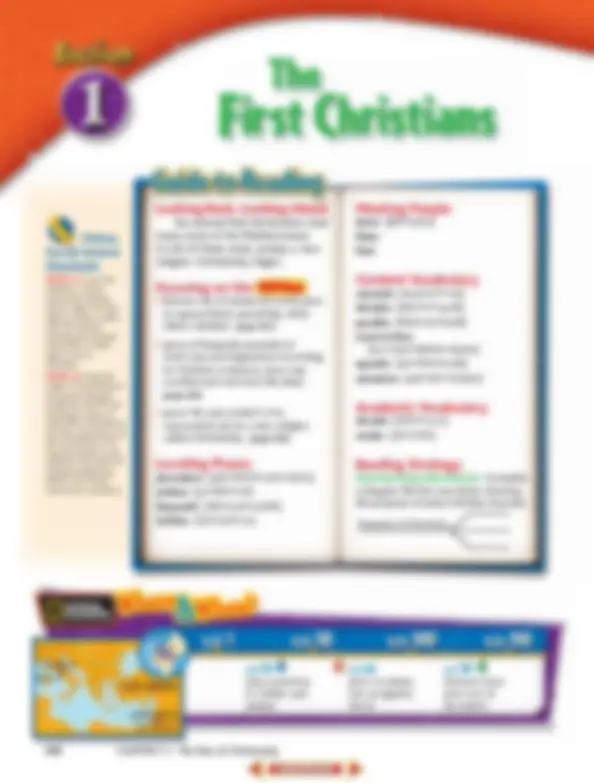
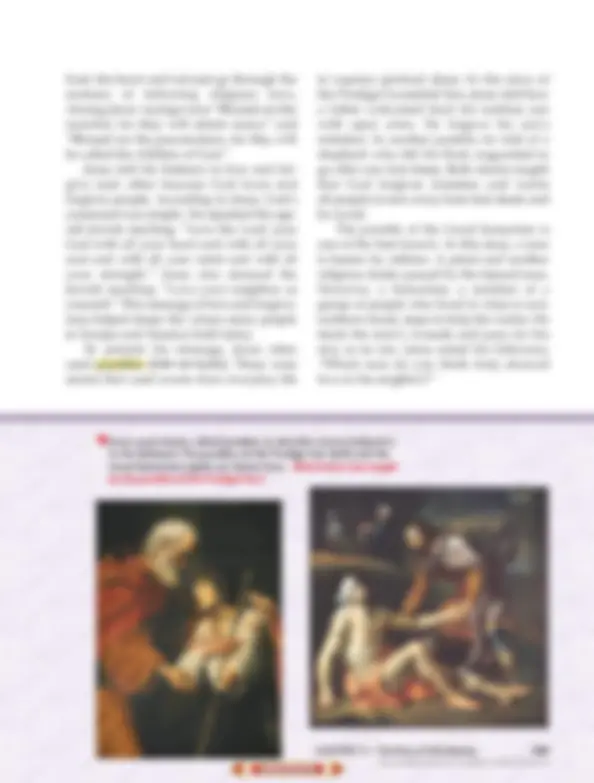

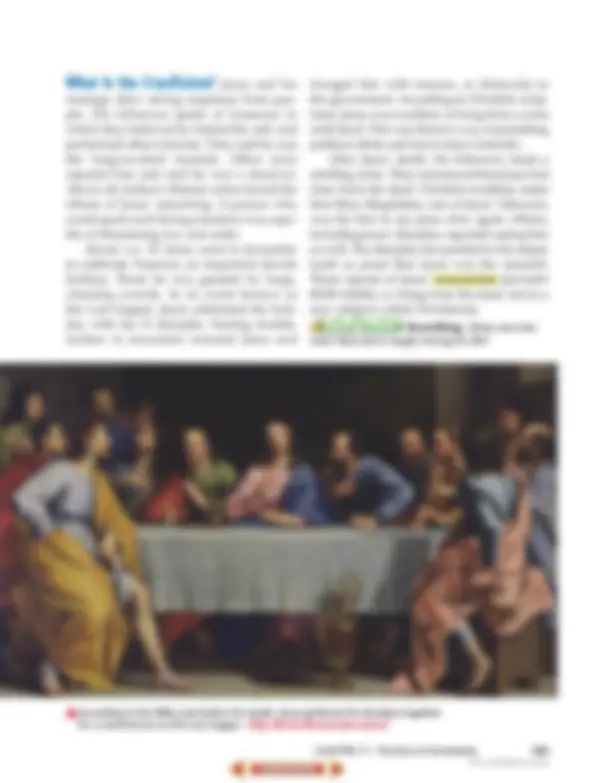


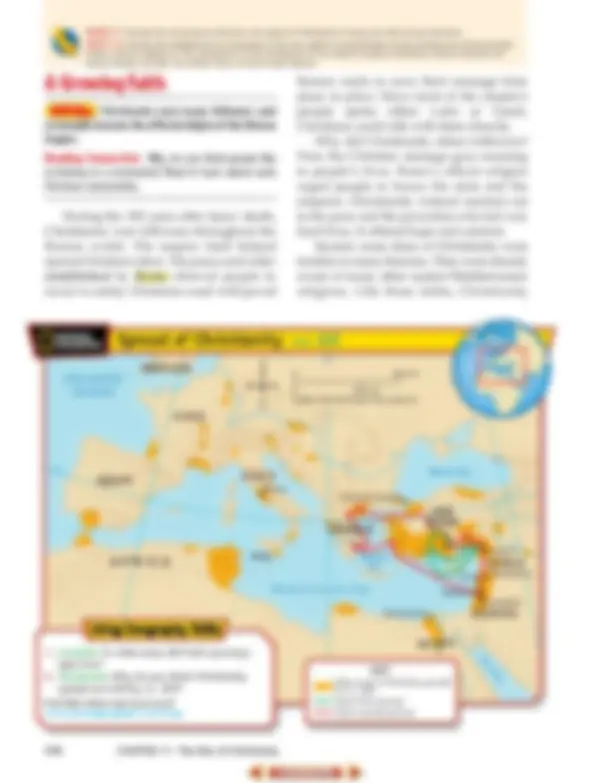
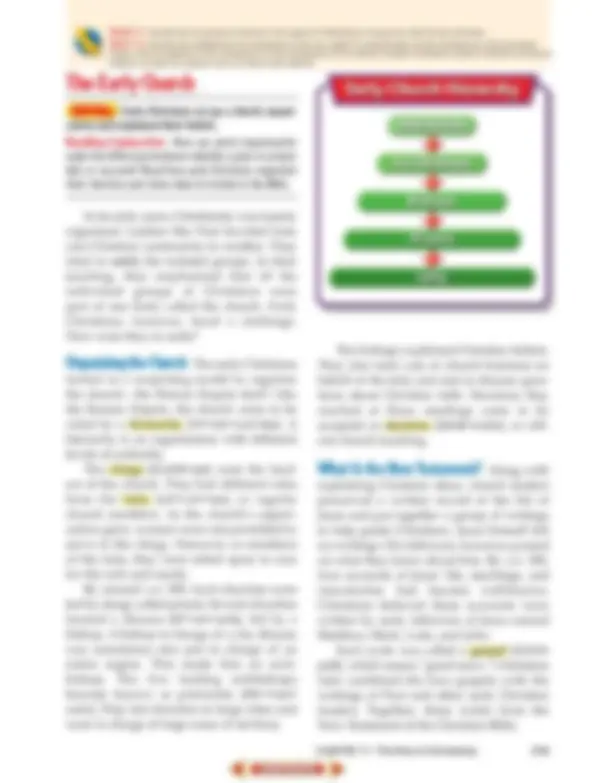


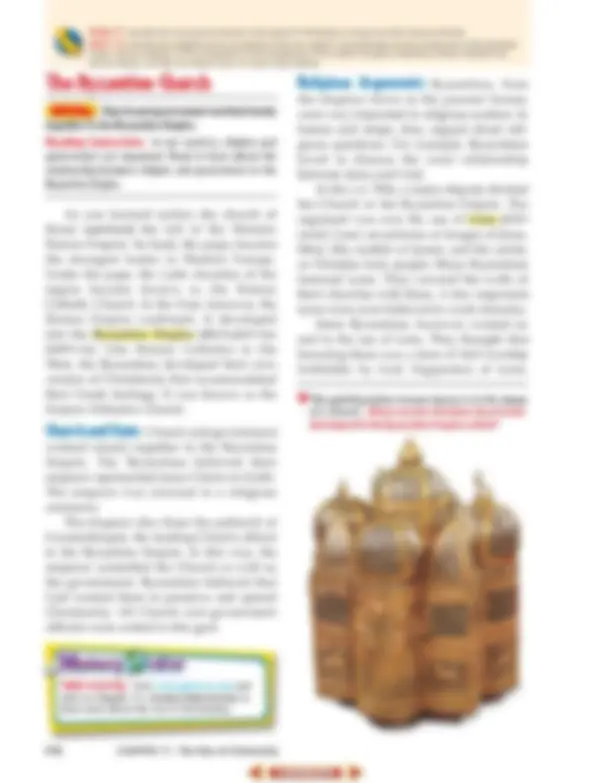
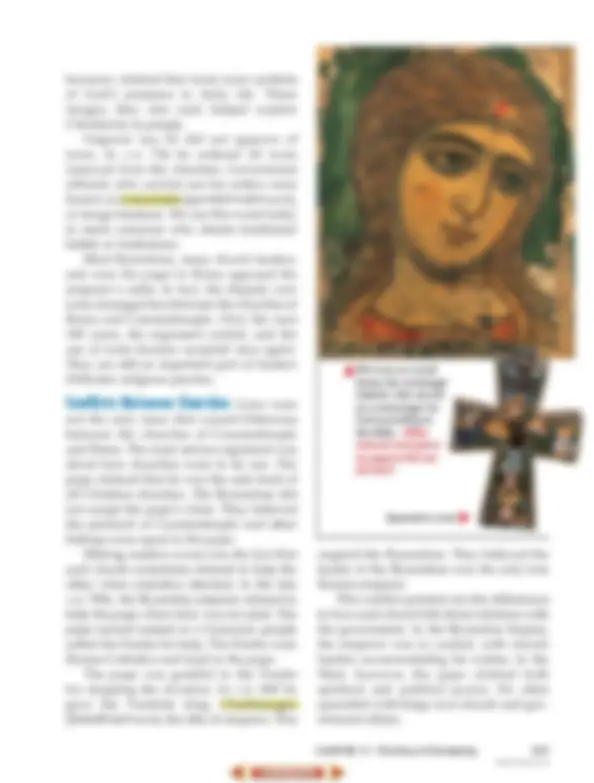
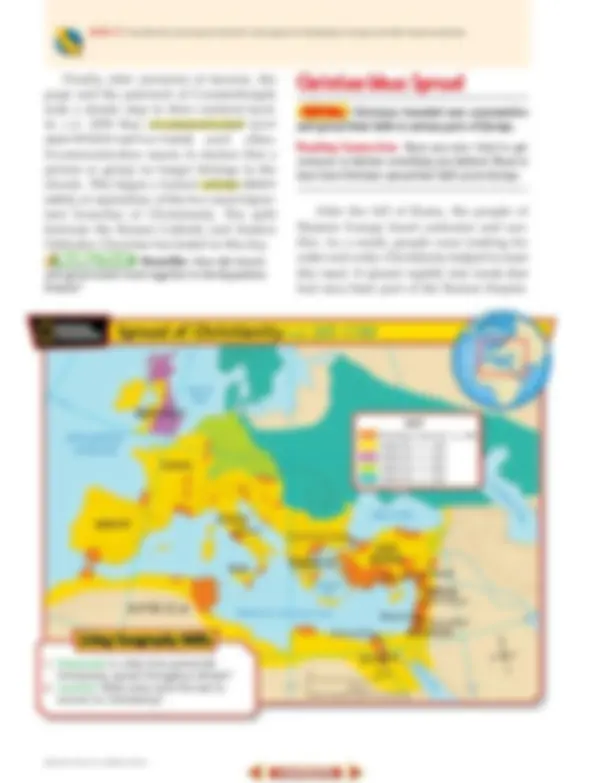
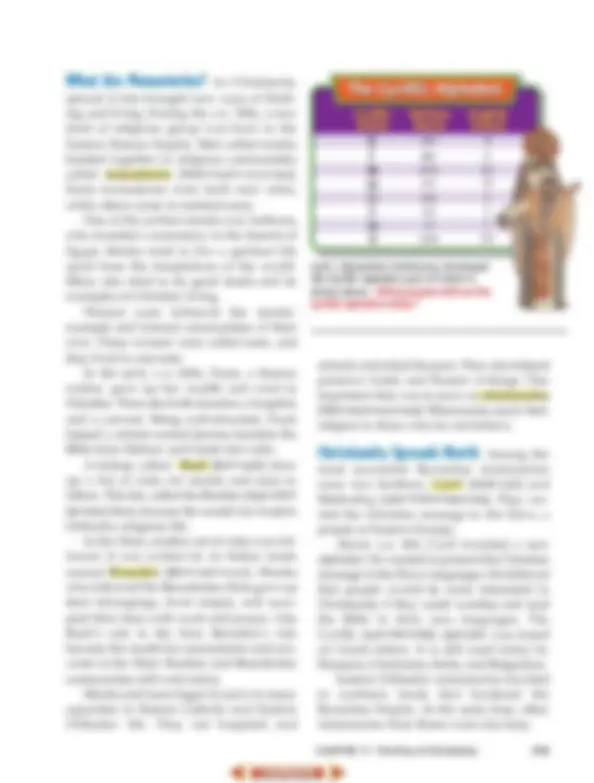

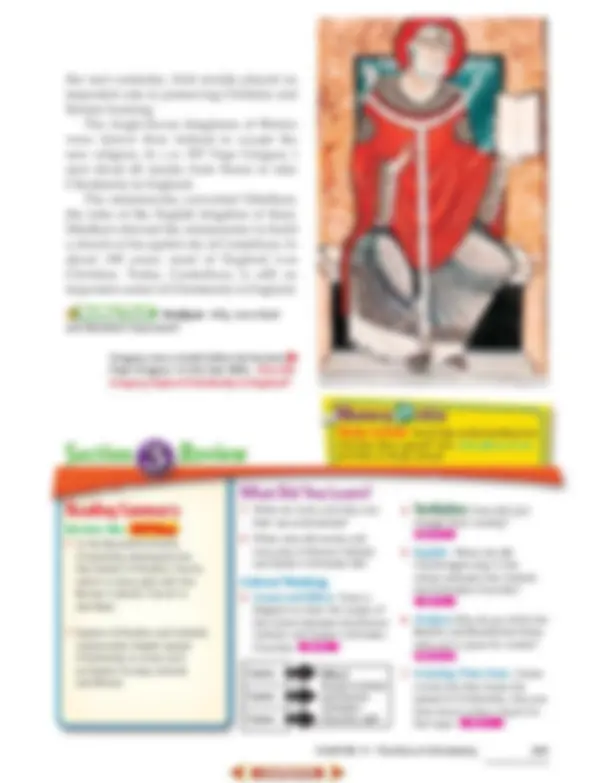
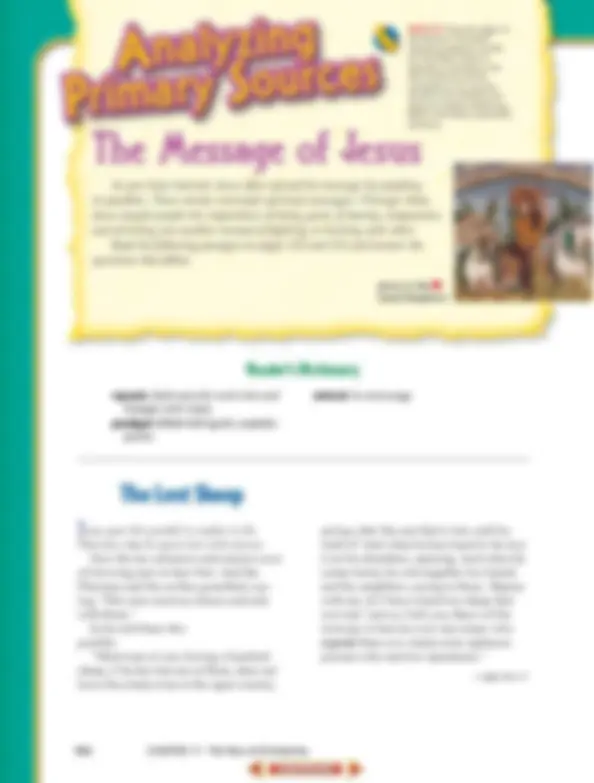
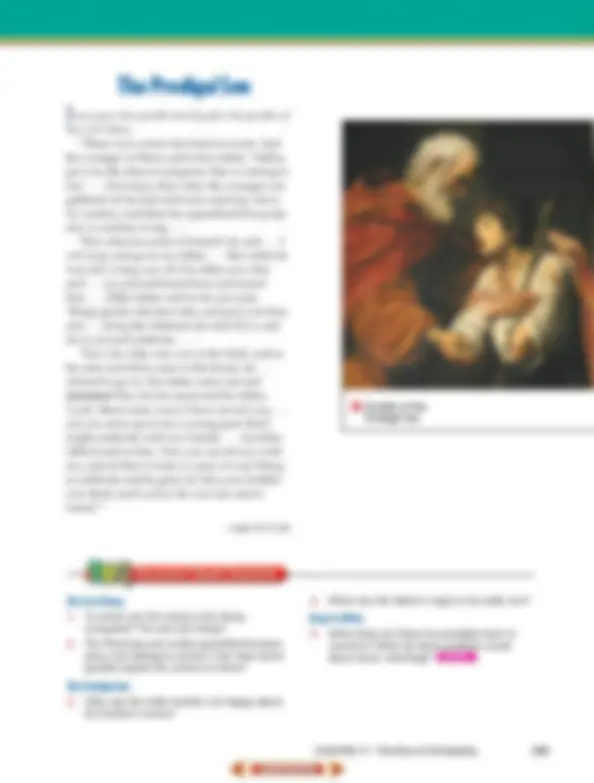
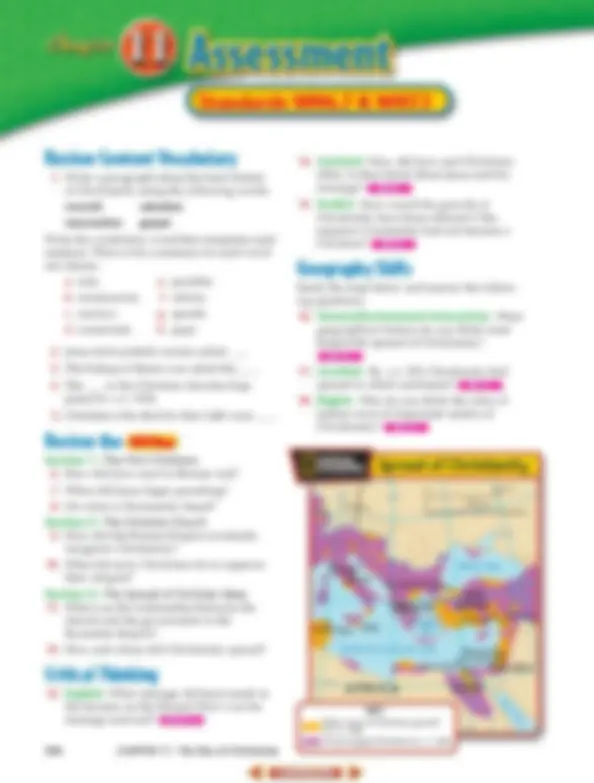

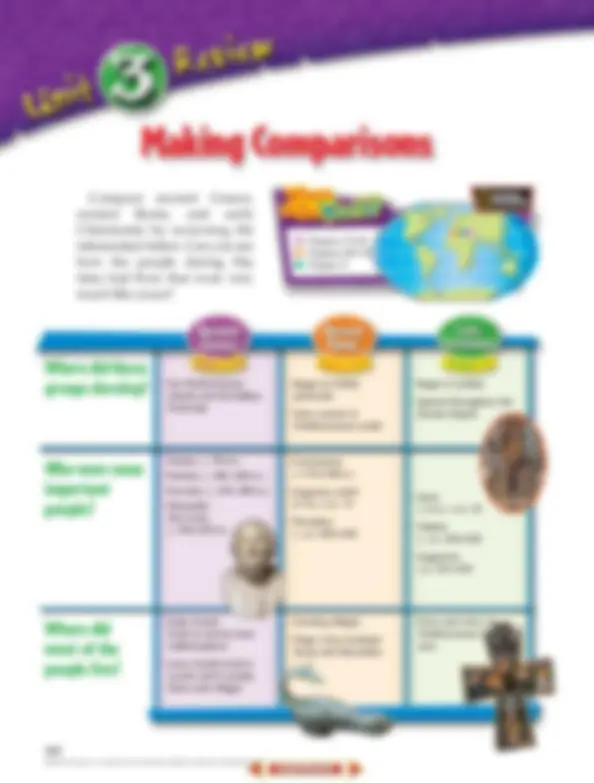
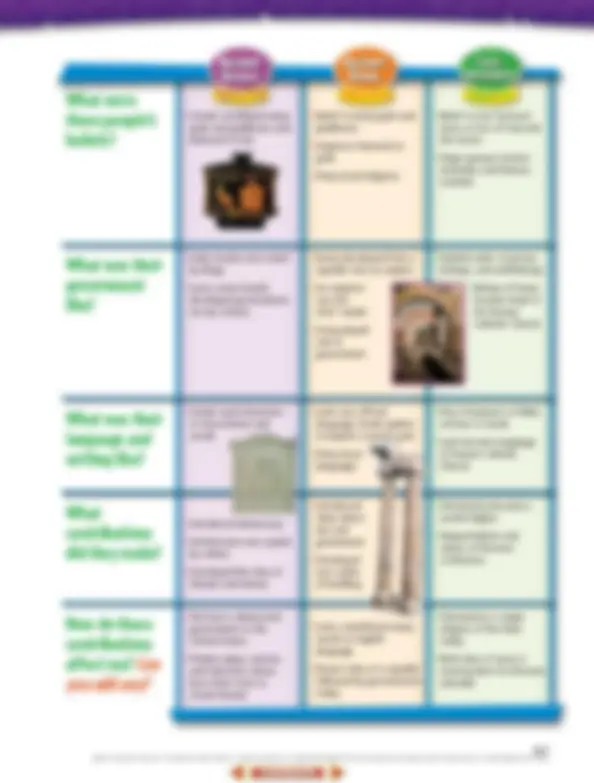


Study with the several resources on Docsity

Earn points by helping other students or get them with a premium plan


Prepare for your exams
Study with the several resources on Docsity

Earn points to download
Earn points by helping other students or get them with a premium plan
Community
Ask the community for help and clear up your study doubts
Discover the best universities in your country according to Docsity users
Free resources
Download our free guides on studying techniques, anxiety management strategies, and thesis advice from Docsity tutors
During the Roman Empire, Jesus of Nazareth began preaching a message of love and forgiveness. His life and teachings led to the rise of Christianity.
Typology: Slides
1 / 32

This page cannot be seen from the preview
Don't miss anything!

























Mount of the Beatitudes on the Sea of Galilee in Israel
Jesus preaches in Galilee and Judaea
A A. .DD. 50. 50 AA ..DD. 400. 400 AA. .DD. 750. 750 AA. .DD. 1100. 1100
Emperor Leo III removes icons from churches
Constantine accepts Christianity
Orthodox and Catholic Churches separate
338–339 Richard T. Nowitz/CORBIS
497
Chapter Overview Visit ca.hss.glencoe.com for a preview of Chapter 11.
The First Christians Studying the past helps us to understand the present. During the Roman Empire, Jesus of Nazareth began preaching a message of love and forgiveness. His life and teachings led to the rise of Christianity. This religion had a great influence on the Roman Empire and on people throughout the world.
The Christian Church Religion shapes how culture develops, just as culture shapes how religion develops. Although the Romans at first persecuted the Christians, in time, Christianity became the official religion of Rome. Early Christians organized the church and collected the New Testament of the Bible.
The Spread of Christian Ideas As different societies interact, they often bring about change in each other. The church and government worked closely together in the Byzantine Empire. Christians founded new communities and spread their faith throughout Europe.
View the Chapter 11 video in the Glencoe Video Program.
Sequencing Information Make this foldable to help you sequence information about the rise of Christianity.
Reading and Writing As you read the chapter, write the important events that occurred in the rise of Christianity.
Step 1 Fold a piece of paper from top to bottom. This makes anaccordion shape.
The Rise of Christianity
Romanspersecute Christians
A.D. 64
A.D. 726
A.D. to preachJesus begins 30
312 A.D. conversionConstantine’s EmperorLeo III removes icons
Christi (^) anity
ise of
Step 3 Unfold and label the time The R line as shown.
Step 4 Fill in important dates as you read like those shown.
Step 2 Then fold back each half to make quarter folds.
Read the following paragraph. Then use the graphic organizer below or create your own to show what happened as monks and nuns began to play more important roles. History is often a chain of causes and effects. The result, or effect, of an event can also be the cause of another effect. Find examples of cause-and-effect chains in the chapter, and show your findings in a graphic organizer.
Read to Write
As you read the chapter, be aware of causes and effects in the history of Christianity. Find at least five causes and their effects, and create graphic organizers to record them. 499
Monks and nuns began to serve in many capacities in Roman Catholic and Eastern Orthodox life. They ran hospitals and schools and aided the poor. They also helped preserve Greek and Roman writ- ings. One important duty was to serve as missionaries (MIH • shuh • NEHR • eez). Missionaries teach their religion to those who do not believe.
— from page 519
CAUSE
EFFECT
EFFECT
EFFECT
Benedictine monks
akg-images/Orsi Battaglini
The
First^ Christians
History Social Science Standards WH6.7.5 Trace the migration of Jews around the Mediter- ranean region and the effects of their conflict with the Romans, including the Romans’ restrictions on their right to live in Jerusalem. WH6.7.6 Note the origins of Christianity in the Jewish Messianic prophecies, the life and teachings of Jesus of Nazareth as described in the New Testament, and the contribution of St. Paul the Apostle to the definition and spread of Christian beliefs (e.g., belief in the Trinity, resurrection, salvation).
Looking Back, Looking Ahead You learned that the Romans ruled many areas of the Mediterranean. In one of these areas, Judaea, a new religion, Christianity, began.
Focusing on the
Locating Places
Meeting People
Peter Paul
Content Vocabulary
resurrection
Academic Vocabulary
Reading Strategy Summarizing Information Complete a diagram like the one below showing the purposes of early Christian churches. Purposes of Churches
Jesus preaches in Galilee and Judaea
Jews in Judaea rise up against Rome
Romans force Jews out of Jerusalem
A A. .DD. 1. 1 AA. .DD. 50. 50 AA. .DD. 100. 100 AA. .DD. 150. 150
Jerusalem
Rome
ASIA MINOR
JUDAEA
500 CHAPTER 11 • The Rise of Christianity
WH6.7.6 Note the origins of Christianity in the Jewish Messianic prophecies, the life and teachings of Jesus of Nazareth as described in the New Testament, and the contribution of St. Paul the Apostle to the definition and spread of Christian beliefs (e.g., belief in the Trinity, resurrection, salvation).
The Life of Jesus
During Roman times, many Jews hoped
uh), or deliverer. This leader would help them win back their freedom. The Israelite prophets had long ago predicted that a messiah would come. Many Jews expected the messiah to be a great king, like David. They thought the messiah would restore the past glories of the Israelite kingdom. A few decades before the first Jewish revolt against Rome, a Jew named Jesus
about A. D. 30 to A. D. 33, Jesus traveled
LEE), the region just north of Judaea, preach- ing his ideas. Crowds gathered to hear him teach and lecture. He soon assembled a small band of 12 close followers called
What Did Jesus Teach? According to the Christian Bible, Jesus preached that God was coming soon to rule the world. He urged people to turn from their sins. He also told them that following Jewish reli- gious laws was not as important as having a relationship with God, whom Jesus referred to as his Father. The main points of Jesus’ message are given in a group of sayings known as the Sermon on the Mount. In them, Jesus made it clear that a person had to love and forgive
Jesus traveled throughout the regions of Judaea and Galilee, preaching to all who would listen to his religious message. In the Sermon on the Mount, illustrated below, Jesus described God’s love and how to be a good person. At right, Jesus is shown as the Good Shepherd, a popular image in early Christian art. What did Jesus teach about Jewish religious laws?
The Teachings of Jesus The Teachings of Jesus
502 CHAPTER 11 • The Rise of Christianity (l)Reunion des Musees Nationaux/Art Resource, NY, (r)Scala/Art Resource, NY
from the heart and not just go through the motions of following religious laws. Among Jesus’ sayings were “Blessed are the merciful, for they will obtain mercy” and “Blessed are the peacemakers, for they will be called the children of God.” Jesus told his listeners to love and for- give each other because God loves and forgives people. According to Jesus, God’s command was simple. He repeated the age- old Jewish teaching: “Love the Lord your God with all your heart and with all your soul and with all your mind and with all your strength.” Jesus also stressed the Jewish teaching: “Love your neighbor as yourself.” This message of love and forgive- ness helped shape the values many people in Europe and America hold today. To present his message, Jesus often
stories that used events from everyday life
to express spiritual ideas. In the story of the Prodigal (wasteful) Son, Jesus told how a father welcomed back his reckless son with open arms. He forgave his son’s mistakes. In another parable, he told of a shepherd who left his flock unguarded to go after one lost sheep. Both stories taught that God forgives mistakes and wants all people to turn away from bad deeds and be saved. The parable of the Good Samaritan is one of the best known. In this story, a man is beaten by robbers. A priest and another religious leader passed by the injured man. However, a Samaritan, a member of a group of people who lived in what is now northern Israel, stops to help the victim. He treats the man’s wounds and pays for his stay at an inn. Jesus asked his followers, “Which man do you think truly showed love to his neighbor?”
Jesus used stories, called parables, to describe correct behaviors to his followers. The parables of the Prodigal Son (left) and the Good Samaritan (right) are shown here. What lesson was taught by the parable of the Prodigal Son?
CHAPTER 11 • The Rise of Christianity 503 (l)Erich Lessing/Art Resource, NY, (r)Tate Gallery, London/Art Resource, NY
CHAPTER 11 • The Rise of Christianity 505
What Is the Crucifixion? Jesus and his message drew strong responses from peo- ple. His followers spoke of instances in which they believed he healed the sick and performed other miracles. They said he was the long-awaited messiah. Other Jews rejected him and said he was a deceiver. Above all, Judaea’s Roman rulers feared the effects of Jesus’ preaching. A person who could spark such strong reactions was capa- ble of threatening law and order. About A.D. 33, Jesus went to Jerusalem to celebrate Passover, an important Jewish holiday. There he was greeted by large, cheering crowds. In an event known as the Last Supper, Jesus celebrated the holi- day with his 12 disciples. Fearing trouble, leaders in Jerusalem arrested Jesus and
According to the Bible, just before his death, Jesus gathered his disciples together for a meal known as the Last Supper. Why did the Romans fear Jesus?
charged him with treason, or disloyalty to the government. According to Christian scrip- tures, Jesus was crucified, or hung from a cross until dead. This was Rome’s way of punishing political rebels and lower-class criminals. After Jesus’ death, his followers made a startling claim. They announced that Jesus had risen from the dead. Christian tradition states that Mary Magdalene, one of Jesus’ followers, was the first to see Jesus alive again. Others, including Jesus’ disciples, reported seeing him as well. The disciples also pointed to his empty tomb as proof that Jesus was the messiah.
new religion called Christianity. Describing What were the main ideas Jesus taught during his life?
Louvre, Paris/Bridgeman Art Library
WH6.7.6 Note the origins of Christianity in the Jewish Messianic prophecies, the life and teachings of Jesus of Nazareth as described in the New Testament, and the contribution of St. Paul the Apostle to the definition and spread of Christian beliefs (e.g., belief in the Trinity, resurrection, salvation). WH6.7.7 Describe the circumstances that led to the spread of Christianity in Europe and other Roman territories.
The First Christians
Jesus’ disciples began to spread the mes- sage of Jesus and his resurrection. Small groups in the Greek-speaking cities of the eastern Mediterranean accepted this mes- sage. Some were Jews, but others were not.
Sermon on the Mount Jesus encouraged his disciples with the Sermon on the Mount. “Happy are you when men insult you and perse- cute you and tell all kinds of evil lies against you because you are my followers. Be happy and glad, for a great reward is kept for you in heaven. This is how the prophets who lived before you were persecuted.” —Matthew 5:11–
Why does Jesus tell his followers to ignore—even rejoice in—persecution?
Jesus and his followers
506 CHAPTER 11 • The Rise of Christianity
Those who accepted Jesus and his teachings became known as Christians and referred to him as Jesus Christ. The word Christ comes from Christos, a Greek word for “messiah.” The early Christians formed churches, or communities for worship and instruc- tion. They met in people’s houses, many of which were owned by women. At these gatherings, Christians prayed and studied the Hebrew Bible. They also shared in a rit- ual meal like the Last Supper to remember Jesus’ death and resurrection.
Who Were Peter and Paul? Apostles
who had been chosen by Jesus to spread his message, played an important role in the growth of Christianity. Perhaps the two most important were Peter and Paul. Peter was a Jewish fisher. He had known Jesus while he was alive and had been one of the original 12 people Jesus had called to preach his message. Christian tradition states that he went to Rome after the death of Jesus and helped establish a church there. Today, the leader of Catholic Christians resides in Rome. Paul of Tarsus was another important Christian leader. He was a well-educated Jew and a Roman citizen. Paul at first worked to stop Christian ideas from spread- ing in Jerusalem. The chief Jewish priest in
in the city from spreading their ideas. While on the road to Damascus, Paul had an unusual experience. According to Christian belief, he had a vision of a great light and heard Jesus’ voice. Paul became a Christian and spent the rest of his life spreading Jesus’ message. Paul traveled widely, founding churches throughout the eastern Mediterranean.
The New York Public Library/Art Resource, NY
Reading Summary
Review the
CA 6WA2.
CA HI2.
CA HR5.
CA 6RC2.
What Did You Learn?
508 CHAPTER 11 • The Rise of Christianity
What Do Christians Believe? From the beginning, Christians taught that Jesus was the Son of God and had come to save people. By accepting Jesus and his teach-
shuhn), or be saved from sin and allowed to enter heaven. Like Jesus, after death they would be resurrected and join God in ever- lasting life. Because of their faith in Jesus, Christians began to understand God in a new way. Like the Jews, Christians believed in the God of Israel and studied the Hebrew Bible. However, most Christians came to believe that the one God existed in three persons: Father, Son, and Holy Spirit. This idea became known as the Trinity, which comes from a word meaning “three.”
Identify Who were Peter and Paul, and why were they important?
Christian Beliefs
This painting shows the apostle Peter preaching to followers. What was the role of apostles in the spread of Christianity?
Study Central Need help understanding how Christianity came about? Visit ca.hss.glencoe.com and click on Study Central.
akg-images/Orsi Battaglini
The
Christian^ Church
Looking Back, Looking Ahead In the last section, you read about the origins of Christianity. In this section, you will discover how Christianity grew and was organized.
Focusing on the
Locating Places Rome
Meeting People
Content Vocabulary
pope
Academic Vocabulary
Reading Strategy Organizing Information Complete a diagram like the one below showing reasons for the growth of Christianity.
Reasons for Growth of Christianity
Romans begin to persecute Christians
Constantine accepts Christianity
Christianity becomes the official religion of the Roman Empire
A A. .DD. 100. 100 AA ..DD. 300. 300 AA. .DD. 500. 500
Jerusalem
Rome (^) Constantinople
CHAPTER 11 • The Rise of Christianity 509
History Social Science Standards WH6.7.7 Describe the circumstances that led to the spread of Christianity in Europe and other Roman territories. WH7.1.3 Describe the establishment by Con- stantine of the new capital in Constanti- nople and the development of the Byzantine Empire, with an emphasis on the consequences of the development of two distinct European civilizations, Eastern Orthodox and Roman Catholic, and their two distinct views on church-state relations.
Christian Catacombs Christians
Connecting to the Past
1. Why did Christians bury their dead in catacombs? 2. What skills do you think would be necessary to dig and plan catacombs?
appealed to the emotions and promised hap- piness after death. Finally, Christianity gave people the chance to be part of a caring group. Within their churches, Christians not only wor- shiped together but helped each other. They took care of the sick, the elderly, widows, and orphans. Many women found that Christianity offered them new roles. They ran churches from their homes, spread Jesus’ message, and helped care for those in need.
How Did the Romans Treat Christians? Over time, Roman officials began to see the Christians as a threat to the government. All people in the empire were usually allowed to worship freely, but the Romans expected everyone to honor the emperor as a god. Christians, like the Jews, refused to do this. They claimed that only God could be worshiped. Christians also refused to serve in the army or hold public office. They criticized Roman festivals and games. As a result, the Romans saw the Christians as traitors who should be punished. In A. D. 64 the Roman government
or mistreat, Christians. At this time, the emperor Nero accused Christians of starting a terrible fire that burned much of Rome. Christianity was made ille- gal, and many Christians were killed. Other persecutions followed. During these difficult times, many Christians
willing to die rather than give up their beliefs. At that time, Romans required dead people to be cremated, or burned to ashes. Christians wanted to bury their dead. They were forced to bury their dead outside Rome in catacombs, or underground burial places. Catacombs were also used for religious services dur- ing times of persecution.
Christian catacombs in Rome
511
Scala/Art Resource, NY
Rome Adopts Christianity Despite the enormous challenges, Christianity spread. Over time it even began to draw people from all classes. In the A.D. 200s as invaders attacked the empire, many Romans became worried. They admired the faith and courage of the Christians. At the same time, many Christians started to accept the empire. In the early A. D. 300s the emperor Diocletian carried out the last great perse- cution of Christians. Diocletian failed, and Roman officials began to realize that Christianity had grown too strong to be destroyed by force. Then, in A. D. 312, the Roman emperor
Christianity. According to tradition, Constantine saw a flaming cross in the sky as he was about to go into battle. Written
beneath the cross were the words “In this sign you will conquer.” Constantine won the battle and believed that the Christian God had helped him. In A.D. 313 Constantine issued an order called the Edict of Milan. It gave religious freedom to all people and made Christianity legal. Constantine began giving govern- ment support to Christianity. With the help
built churches in Rome and Jerusalem. He also let church officials serve in government and excused them from paying taxes. Constantine’s successor, the emperor
Christianity Rome’s official religion in A. D. 392. At the same time, he outlawed other religions. Explain Why did the Romans see the Christians as traitors?
Constantine led his troops to victory at the Battle of the Milvian Bridge after his conversion to Christianity. Constantine’s enemies were defeated as a bridge made of boats collapsed under their weight. The X and P sym- bols on the shields represented the first two letters of the Greek word for Christ. How did Constantine’s Edict of Milan support Christianity?
Constantine’s Conversion Constantine’s Conversion
514 CHAPTER 11 • The Rise of Christianity
Reading Summary
Review the
Critical Thinking
3. Organizing Information Draw a chart like the one below. Fill in details describing how each emperor helped Christianity to grow. 4. Analyze Following Jesus’ death, why was Christianity able to attract followers? 5. Analyze Why do you think the Christian church became a hierarchy? 6. How did the Christian religion affect the Roman Empire? 7. Writing Questions Write five questions that you might have asked Constantine about Christianity. CA HR1. CA 6RC2.
CA HI2.
CA 6RC2.
CA HI2.
CA 6RC2.
What Did You Learn?
Diocletian Constantine Theodosius
Roman Emperors
Other important writings also influ- enced early Christians. Scholars known as the Church Fathers wrote books to explain church teachings. One leading Church Father was a bishop in North Africa named Augustine. In his writings, Augustine defended Christianity against its oppo- nents. He wrote The City of God —one of the first history books written from a Christian
viewpoint. He also wrote a work called Confessions. It was an account of his per- sonal journey to the Christian faith.
Who Is the Pope? As the church grew, the bishop of Rome, who was also the patriarch of the West, claimed power over the other bishops. He believed that he had the authority of Peter, Jesus’ disciple. Also, his diocese was in Rome, the empire’s capital. By A. D. 600, the bishop of Rome had gained a special title— pope. The title comes from a Latin word meaning “father.” Latin- speaking Christians accepted the pope as head of the church. Their churches became known as the Roman Catholic Church. Greek-speaking Christians rejected the pope’s authority over them. As you will learn, they formed their own church in the Eastern Roman Empire. Identify What are the gospels, and why are they significant?
Matthew wrote one of the four gospels in the New Testament of the Christian Bible. What is the subject of the gospels of Matthew, Mark, Luke, and John?
Study Central Need help understanding the early Christian church? Visit ca.hss.glencoe.com and click on Study Central.
Cott Nero DIV f.25v Portrait of St. Matthew/British Library, London/Bridgeman Art Library
The (^) Spread (^) of
Christian^ Ideas
Looking Back, Looking Ahead In the last section, you read about the growth of the Christian church. In this section, you will learn how the church underwent a great division and how Christians spread their faith to new lands.
Focusing on the
Locating Places Byzantine Empire
Meeting People
Patrick
Content Vocabulary
excommunicate
Academic Vocabulary
Reading Strategy Organizing Information Create a diagram to show the reach of Christian missionaries. Missionaries
Eastern Europe
Britain/ Ireland
Patrick preaches Christianity in Ireland
Emperor Leo III removes icons from churches
Eastern Orthodox and Roman Catholic Churches separate
A A. .DD. 400. 400 AA. .DD. 800. 800 AA. .DD. 1200. 1200
AFRICA
ASIA MINOR GREECE
ITALY
GAUL SPAIN
BRITAIN
IRELAND
Rome
Jerusalem
Constantinople
CHAPTER 11 • The Rise of Christianity 515
History Social Science Standards WH6.7.7 Describe the circumstances that led to the spread of Chris- tianity in Europe and other Roman territories. WH7.1.3 Describe the establishment by Constantine of the new capital in Constantinople and the development of the Byzantine Empire, with an emphasis on the consequences of the development of two distinct European civilizations, Eastern Orthodox and Roman Catholic, and their two distinct views on church-state relations.